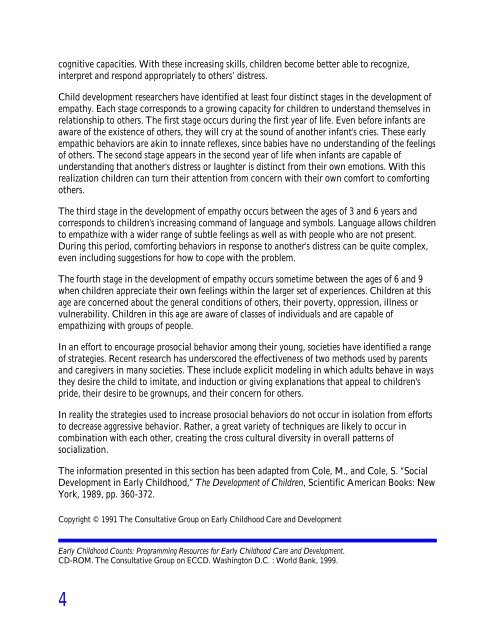the development of aggression and prosocial behavior in
the development of aggression and prosocial behavior in
the development of aggression and prosocial behavior in
Create successful ePaper yourself
Turn your PDF publications into a flip-book with our unique Google optimized e-Paper software.
cognitive capacities. With <strong>the</strong>se <strong>in</strong>creas<strong>in</strong>g skills, children become better able to recognize,<br />
<strong>in</strong>terpret <strong>and</strong> respond appropriately to o<strong>the</strong>rs’ distress.<br />
Child <strong>development</strong> researchers have identified at least four dist<strong>in</strong>ct stages <strong>in</strong> <strong>the</strong> <strong>development</strong> <strong>of</strong><br />
empathy. Each stage corresponds to a grow<strong>in</strong>g capacity for children to underst<strong>and</strong> <strong>the</strong>mselves <strong>in</strong><br />
relationship to o<strong>the</strong>rs. The first stage occurs dur<strong>in</strong>g <strong>the</strong> first year <strong>of</strong> life. Even before <strong>in</strong>fants are<br />
aware <strong>of</strong> <strong>the</strong> existence <strong>of</strong> o<strong>the</strong>rs, <strong>the</strong>y will cry at <strong>the</strong> sound <strong>of</strong> ano<strong>the</strong>r <strong>in</strong>fant's cries. These early<br />
empathic <strong>behavior</strong>s are ak<strong>in</strong> to <strong>in</strong>nate reflexes, s<strong>in</strong>ce babies have no underst<strong>and</strong><strong>in</strong>g <strong>of</strong> <strong>the</strong> feel<strong>in</strong>gs<br />
<strong>of</strong> o<strong>the</strong>rs. The second stage appears <strong>in</strong> <strong>the</strong> second year <strong>of</strong> life when <strong>in</strong>fants are capable <strong>of</strong><br />
underst<strong>and</strong><strong>in</strong>g that ano<strong>the</strong>r's distress or laughter is dist<strong>in</strong>ct from <strong>the</strong>ir own emotions. With this<br />
realization children can turn <strong>the</strong>ir attention from concern with <strong>the</strong>ir own comfort to comfort<strong>in</strong>g<br />
o<strong>the</strong>rs.<br />
The third stage <strong>in</strong> <strong>the</strong> <strong>development</strong> <strong>of</strong> empathy occurs between <strong>the</strong> ages <strong>of</strong> 3 <strong>and</strong> 6 years <strong>and</strong><br />
corresponds to children's <strong>in</strong>creas<strong>in</strong>g comm<strong>and</strong> <strong>of</strong> language <strong>and</strong> symbols. Language allows children<br />
to empathize with a wider range <strong>of</strong> subtle feel<strong>in</strong>gs as well as with people who are not present.<br />
Dur<strong>in</strong>g this period, comfort<strong>in</strong>g <strong>behavior</strong>s <strong>in</strong> response to ano<strong>the</strong>r's distress can be quite complex,<br />
even <strong>in</strong>clud<strong>in</strong>g suggestions for how to cope with <strong>the</strong> problem.<br />
The fourth stage <strong>in</strong> <strong>the</strong> <strong>development</strong> <strong>of</strong> empathy occurs sometime between <strong>the</strong> ages <strong>of</strong> 6 <strong>and</strong> 9<br />
when children appreciate <strong>the</strong>ir own feel<strong>in</strong>gs with<strong>in</strong> <strong>the</strong> larger set <strong>of</strong> experiences. Children at this<br />
age are concerned about <strong>the</strong> general conditions <strong>of</strong> o<strong>the</strong>rs, <strong>the</strong>ir poverty, oppression, illness or<br />
vulnerability. Children <strong>in</strong> this age are aware <strong>of</strong> classes <strong>of</strong> <strong>in</strong>dividuals <strong>and</strong> are capable <strong>of</strong><br />
empathiz<strong>in</strong>g with groups <strong>of</strong> people.<br />
In an effort to encourage <strong>prosocial</strong> <strong>behavior</strong> among <strong>the</strong>ir young, societies have identified a range<br />
<strong>of</strong> strategies. Recent research has underscored <strong>the</strong> effectiveness <strong>of</strong> two methods used by parents<br />
<strong>and</strong> caregivers <strong>in</strong> many societies. These <strong>in</strong>clude explicit model<strong>in</strong>g <strong>in</strong> which adults behave <strong>in</strong> ways<br />
<strong>the</strong>y desire <strong>the</strong> child to imitate, <strong>and</strong> <strong>in</strong>duction or giv<strong>in</strong>g explanations that appeal to children's<br />
pride, <strong>the</strong>ir desire to be grownups, <strong>and</strong> <strong>the</strong>ir concern for o<strong>the</strong>rs.<br />
In reality <strong>the</strong> strategies used to <strong>in</strong>crease <strong>prosocial</strong> <strong>behavior</strong>s do not occur <strong>in</strong> isolation from efforts<br />
to decrease aggressive <strong>behavior</strong>. Ra<strong>the</strong>r, a great variety <strong>of</strong> techniques are likely to occur <strong>in</strong><br />
comb<strong>in</strong>ation with each o<strong>the</strong>r, creat<strong>in</strong>g <strong>the</strong> cross cultural diversity <strong>in</strong> overall patterns <strong>of</strong><br />
socialization.<br />
The <strong>in</strong>formation presented <strong>in</strong> this section has been adapted from Cole, M., <strong>and</strong> Cole, S. “Social<br />
Development <strong>in</strong> Early Childhood,” The Development <strong>of</strong> Children, Scientific American Books: New<br />
York, 1989, pp. 360-372.<br />
Copyright © 1991 The Consultative Group on Early Childhood Care <strong>and</strong> Development<br />
Early Childhood Counts: Programm<strong>in</strong>g Resources for Early Childhood Care <strong>and</strong> Development.<br />
CD-ROM. The Consultative Group on ECCD. Wash<strong>in</strong>gton D.C. : World Bank, 1999.<br />
4
















